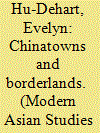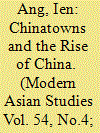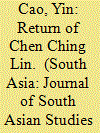|
|
|
Sort Order |
|
|
|
Items / Page
|
|
|
|
|
|
|
| Srl | Item |
| 1 |
ID:
112143


|
|
|
|
|
| Publication |
2012.
|
| Summary/Abstract |
This paper explores two dynamic places and spaces in the Americas, destination of several Asian diasporas-the Chinese, Japanese, and South Asian-as contact and exchange zones. One would be the ethnic enclaves commonly called 'Chinatowns', which stretch over time from the early sixteenth century to the present, and over space from Manila in the Spanish empire across the Pacific to all over the Americas. These Chinatowns, imagined and real and riddled with stereotypes, are well-known tropes on the American landscapes, and need no further preliminary introduction; they are also firmly located within fixed national (or colonial) entities.
The second space has not been historically associated with Asian diasporas in the Americas, although well known for different reasons. Here I refer to 'borderlands', the overlapping space between, over, and above two political national boundaries or borders, in particular the US-Mexican and US-Canadian borderlands, both, coincidentally, clearly marked and delineated by the mid-nineteenth century (1848 and 1846 respectively). Furthermore, as these two transnational/transborder regions are also trans-Pacific, their recognition as an integral part of Asian diasporas is belated and overdue. To make the case further, the study of Asians in the Americas has revealed that Asian migrants, labour, and capital have been historically drawn to these borderlands because they represent dynamic zones of economic development, first in the heyday of maturing American capitalism at the turn of the twentieth century, and again in the glaring eye of current late-capitalist globalization. In other words, Asians have amassed on both sides of these borders for over 100 years, where they have become adept at multiple border crossings, both trans-Pacific and transnational.
|
|
|
|
|
|
|
|
|
|
|
|
|
|
|
|
| 2 |
ID:
174430


|
|
|
|
|
| Summary/Abstract |
In the early twentieth century, Chinatowns in the West were ghettoes for Chinese immigrants who were marginalized and considered ‘other’ by the dominant society. In Western eyes, these areas were the no-go zones of the Oriental ‘other’. Now, more than a hundred years later, traditional Chinatowns still exist in some cities but their meaning and role has been transformed, while in other cities entirely new Chinatowns have emerged. This article discusses how Chinatowns today are increasingly contested sites where older diasporic understandings of Chineseness are unsettled by newer, neoliberal interpretations, dominated by the pull of China's new-found economic might. In particular, the so-called ‘rise of China’ has spawned a globalization of the idea of ‘Chinatown’ itself, with its actual uptake in urban development projects the world over, or a backlash against it, determined by varying perceptions of China's global ascendancy as an amalgam of threat and opportunity.
|
|
|
|
|
|
|
|
|
|
|
|
|
|
|
|
| 3 |
ID:
181677


|
|
|
|
|
| Summary/Abstract |
During World War II, thousands of Chinese soldiers were sent to India for training. Many of them deserted from the army and made a new life in India. Chen Ching Lin was one of these deserters. Following the course of his journey in India from 1943 to 1946, this article not only unearths the little-known experiences of the Chinese deserters in India, but also explores how the Chinese Nationalist Government’s aim to discipline the overseas Chinese communities conflicted with the agenda of British geopolitics. It further contends that modern Chinese and Indian history could be integrated into a single narrative framework from subaltern perspectives.
|
|
|
|
|
|
|
|
|
|
|
|
|
|
|
|
|
|
|
|
|